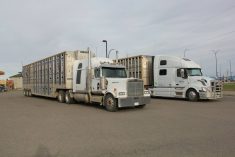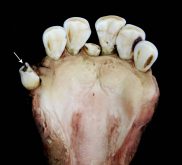More holes in the side of a livestock transport trailer don’t necessarily create better airflow for the animals, researchers have found.
Dr. Karen Schwartzkopf-Genswein, senior researcher at Agriculture Canada’s research centre in Lethbridge, said a study looking at two types of patterns — the duffy and the punch hole — produced surprising results.
The duffy pattern has 12 percent porosity and the punch hole offers 10 percent, she told the Saskatchewan Stock Growers Association convention.
Researchers weren’t expecting much difference in results because the difference isn’t that large. However, the duffy actually performed worse than the punch hole.
Read Also

Animal protection delivery to change in Saskatchewan
The Saskatchewan government is looking for a new agency to handle animal welfare after Animal Protection Services of Saskatchewan decided not to renew its contract next year.
“It’s higher in temperature and humidity in every compartment, despite higher porosity,” said Schwartzkopf-Genswein.
“This really told us it’s not about the number of holes in the trailer; it’s about how the air flows.”
She said few companies have done work in this area, but it could be something to consider as Canada looks to revise its 37-year-old transport regulations.
“We need to do a lot in trailer design because what we think might improve ventilation on the trailer isn’t necessarily doing that,” she said.
Another study looked at the use of sideboards on trucks. Eleven loads were in trucks where the sideboards were in groups and alternated.
Three loads were in trailers that had a sideboard over every second ventilated panel, and three were totally open.
Again, the result was surprising.
“Temperature and humidity was greater in all trailers, regardless of the pattern we had, during stationary periods,” said Schwartzkopf-Genswein.
“In transit, trucks using more boarding were less humid than the outside. That seems opposite to what we would think.”
Temperature inside the trailer is a key factor in animal condition during transport. Shrink increases by .04 percent for every one degree increase in temperature.
As well, a two-hour stop at the border, for example, could see the temperature increase by 15 or 20 C, she said.
The research also found that temperatures lower than -15 C and higher than 15 C tend to increase bad welfare outcomes, as did space per animal of less than .5 sq. metres or higher than 1.5 sq. metres.
“Not much has been done on loading density in the last 20 years, and with the new regulations coming, we thought we should look to see where that would sit,” she said.
The results could be guidelines for the new rules, she added.
Canada allows the longest time for livestock in transit and doesn’t require rest stops.
Schwartzkopf-Genswein said shrink starts to plateau at about 30 hours in transit, but that doesn’t mean the animals can go longer without suffering consequences.
“If you look at what happens at that point, those animals have lost all urine, feces, gut fill,” she said.
“What you’re getting at that point is actual tissue loss in the body. You don’t want to get to that point.”
Schwartzkopf-Genswein recommended transport of no more than 24 to 28 hours.
Rest stops are controversial. Some suggest that stopping, unloading and reloading adds more stress to already stressed livestock, while others argue they need to eat and drink.
One study at the rest stop at Thunder Bay, Ont., found that the cattle did indeed eat, drink and lie down.
“The question is how long is appropriate before welfare is im-proved to the point they can go on,” she said.
Facilities have to be designed so that all the cattle can receive adequate feed, water and space. She said there is little information on how loading and unloading affects animals. It would require a big study, she added.
The results would depend on the type of cattle involved — fat cattle in good condition compared to cull cows, for example.
Schwartzkopf-Genswein said European transporters put water and feed on trucks. It’s not impossible, she added, but researchers need to determine how much the livestock actually need and how they could access it, considering loading density.
















